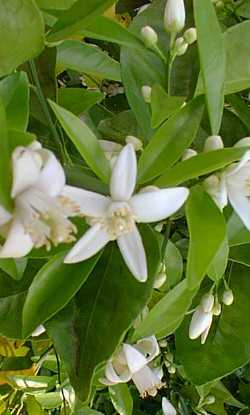Sunset®: 8-9, 12-24
USDA: 9b-11
Frost Tolerance: Tolerates light frosts
Sun Exposure: Full sun
Growth Habits: Evergreen tree, up to 25 feet tall (7.5 m), 25 feet spread (7.5 m)
Watering Needs: Don't let the soil dry completely, good drainage
Propagation: Grafted

Tree of moderate size, probably the most popular of all citrus fruits, available in a number of varieties that ripen at various seasons. Hamlin is one of the earliest, ripening in November, followed by Pine- apple and Washington Navel, which ripen from December to February, and then by Valencia, which ripens in April or later and can be "stored on the tree" into the summer months.
| Kind | Variety | Zones (Sunset) | Maturity Zone 13 | Remarks | |
| Navel | Cara Cara | 12,13 | Dec-January | Pigmented navel orange with a crimson flesh similar to red grapefruit. The flavor and peel color of the ‘Cara Cara’ is similar to other navel orange varieties. Fruit segments are attractive in salads due to its crimson color. | |
| Navel | Fukumoto | 12,13 | 10/15-12/31 | Fukumoto’ an early-season, medium-sized navel which should be harvested by the end of October or early November. Currently being evaluated for Arizona, this variety has performed well in California trials. Due to its early maturity it may not have full orange peel color at the time of harvest although it is ready to eat. | |
| Navel | Lane Late | 12,13 | January-March | ‘Lane Late’ is one of many new Australian late season navels. These are often called summer navels; however, here in Arizona they can be harvested beginning in January. There are over 13 different varieties of late navels with the ‘Lane Late’ being one of the most promising. It is currently being evaluated for Arizona conditions. Other varieties include ‘Autumn Gold’, ‘Barnsfield’, ‘Chislett’, ‘Powell’, and ‘Summer Gold’. | |
| Navel | Parent Washington | 12,13 | Nov-January | ‘Parent Washington’ is probably the most popular navel grown in the Salt River Valley. This mid-season navel variety produces a large fruit which has good quality. Harvest beginning around Thanksgiving or the first of December. Other mid-season navels include ‘Atwood’, ‘Fisher’, ‘Newhall’, ‘Robertson’, ‘Spring’, and ‘Thompson Improved.’ | |
| Sweet | Diller | 8,9,12-24 | Dec-February | ‘Diller’ originated in Arizona and is a small-to-medium-size sweet orange with comparatively few seeds. This variety has been popular here in the Salt River Valley due to its productivity. This variety produces the largest yield and is excellent for home use if juice is the main interest. | |
| Sweet | Hamlin | 8,9,12-24 | Nov-January | ‘Hamlin’ is an early-season sweet orange which has done well here in Arizona. The fruit is medium in size with 0-6 seeds per fruit. | |
| Sweet | Marrs | 8,9,12-24 | 10/15-2/15 | ‘Marrs’ is another early-season, semi-dwarf tree, sweet orange. The fruit is medium to large in size and is moderately seedy with 7-10 seeds per fruit. It reaches maturity early in the season, and is best when it fully ripens in November. | |
| Sweet | Pineapple | 8,9,12-24 | Dec-February | ‘Pineapple’ produces fruit which is medium in size and seedy with 15-25 seeds per fruit. It is very productive; however, it tends to alternate bear. The name ‘Pineapple’ came about as some people thought the tree had the flavor or smell of a pineapple. | |
| Sweet | Trovita | 8,9,12-24 | Dec-February | ‘Trovita’ is an excellent sweet orange and produces well here in Arizona. The fruit is medium-to-large in size with 6-10 seeds per fruit. | |
| Valencia | Campbell | 8,9,12-24 | Feb-May | The fruit is medium in size withfew seeds (0-6). | |
| Valencia | Delta | 8,9,12-24 | Feb-May | Seedless. | |
| Valencia | Midknight | 8,9,12-24 | Feb-May | Seedless. | |
| Valencia | Olinda | 8,9,12-24 | Feb-May | The fruit is medium in size withfew seeds (0-6). | |
| Blood | Moro | 8,9,12-24 | 11/5-3/1 | Doesn't always develop the red internal color in the warm Arizona climate. | |
| Blood | Ruby | 8,9,12-24 | Jan-February | Doesn't always develop the red internal color in the warm Arizona climate. | |
| Blood | Salustiana | 8,9,12-24 | Jan-February | Produces the most consistent dark red internal color. | |
| Blood | Sanguinelli | 8,9,12-24 | Jan-March | Doesn't always develop the red internal color in the warm Arizona climate. | |
| Orange, Blood | Tarroco | 8,9,12-24 | Jan-February | Doesn't always develop the red internal color in the warm Arizona climate. |
Links:
Low desert citrus varieties
Desert-Tropicals is dedicated to provide gardening advice, gardening ideas, and information about flower of all kind for landscape and collections.We try to check carefully the identification of the plants on the illustrations as well as the other information from the page, but occasionally errors do occur. if you notice anything that needs to be changed please contact us.Thanks.
© 1998-2020 Philippe Faucon, All Rights Reserved.
